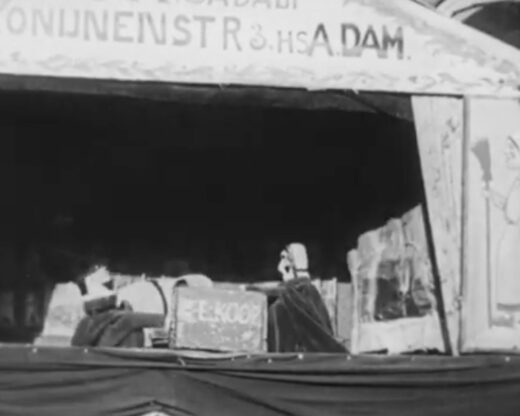
Printed
8 pages
[Jan Klaassen en Katrijn]
[Jan Klaassen en Katrijn] (Jan Klaassen and Katrijn) is a reconstruction by Wim Meilink of the old Jan Klaassen (also written: Jan Claeszen, Jan Klaaszoon, Jan Klaeszn, etc.) farcical show. Meilink published this text with the title Het oude Jan Klaassen-spel (Jan Klaassen’s old game). For this reconstruction, he used the texts of puppeteer Janus Cabalt (1869-1935), who used to perform in his booth in the streets of Amsterdam. These texts were transcribed by Thijs Mol in 1952 and completed with several other sources – fragments of street performances recorded by Feike Boschma, a text (Jan, Gathrijn et Stommetje) lent by Cees Boekraad, and Gerardus Remet’s repertory.
Jan Klaassen is the traditional hero of hand-puppet shows performed in Dutch streets. He is derived from the French Polichinelle, who arrived in the Netherlands at the end of the 17th or beginning of the 18th centuries, but he is also inspired by Jan Claesz, the main character in several comedies by Thomas Asselijn (1620-1701), who was himself inspired by a local character – whose quarrels, domestic squabbles and excessive alcohol consumption are recorded in several documents kept in the archives of the city of Amsterdam.
Meilink’s text is made up of five acts, which are in fact five sketches that can be played individually. Several of them (the uncooperative corpse, the hanging) are recurrent in Punch, Polichinelle or Pulcinella shows.
The hero quarrels with several characters and escapes death
Jan Klaassen announces to the audience that he has just married Katrijn and talks vulgarly about her. When she arrives, he beats her and continues insulting her.
Kleine Ko (a puppet with a very long and expandable neck) arrives on stage dancing, his back to the audience. Jan Klaassen calls out to him, but Kleine Ko shakes his head at every question to answer “no”. His neck expands until it reaches the ceiling, while Jan Klaassen tries to pull him downwards, but Ko disappears.
Jan Klaassen calls Katrijn to get a suit out of his suitcase because it is his birthday. Katrijn initially refuses, but Jan insists, and when she opens the case, he pushes her inside it and locks her in. Jan Klaassen tries to sell the suitcase to a merchant. When the latter opens it, Katrijn grabs him, and Jan pushes them both inside. He leaves singing.
Jan Klaassen is about to become a soldier. A general arrives and tries to train him in weaponry, but Jan Klaassen plays tricks on him. The general is offended and challenges Jan to a duel. They both fight, using guns as swords. Jan Klaassen deceives the general, kills him and calls the undertakers to bury him. They have a difficult time putting the general in the coffin, but they finally manage it and leave singing.
An executioner is setting up the gallows. Jan Klaassen asks the public whether he should be hanged there. When the executioner comes back to hang him, Jan Klaassen pretends not to know where to put his head and asks the executioner to show him. Jan Klaassen takes advantage of the situation and hangs the executioner instead.
First performance
Publications and translations
Wim Meilink, Doopceel van Jan Claeszen. Amsterdam: J.H. de Bussy, 1969.